Central heating pumps can sometimes fail and may need replacing, one way to tell if your pump has a problem is when the radiators in the upstairs of the property are warm, but the downstairs ones are much cooler. This often means that the central heating pump is not working, if you are certain that the pump needs replacing then here are the instructions.
Replacing a central heating pump can be relatively easy or it can be very difficult, often the pumps are located in awkward places and it is quite usual to find that the pump valves have seized or that the nuts connecting them to the pump are impossible to remove.
| Before working on any electrical circuit you must ensure that it is isolated correctly and cannot accidentally be switched back on. Please read the article on safe isolation procedures before doing any electrical work. If you are not 100% certain what you are doing call a qualified electrician. Building regulations are changing all the time and modifying your home electrics could be against new rules and could invalidate your home insurance, if in doubt check first! |

This is the central heating pump that needs changing. These are often in difficult to reach areas, quite often they will be under the floor. In this instance the pump is underneath an airing cupboard.
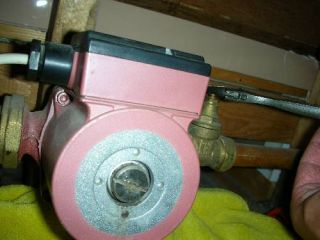
At each side of the pump there are pump valves, if you turn these clockwise it should isolate the water to the pump. If these will not turn or if you close them and the water is passing through the valves you may have to drain down the whole central heating system.
Close both valves using a suitable spanner.
There is an arrow on the pump to show which way the water is being pumped. You must ensure that you fit the new pump so that it pumps in the same direction as the old pump.
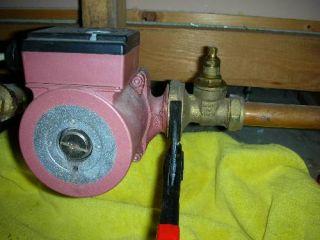
Water will still be in the pump and the valves could be passing and so you need to place some rags and a container underneath the pump to catch the water.
A plastic rubble sack is ideal for this purpose. Undo one nut that secures the valve to the pump in a anti-clockwise direction. Some water should leak out and then it should stop after a few minutes, if it does not stop then the valve could be passing and the central heating system may need draining.
I have seen professional plumbers use the snatch technique here, where the pump valve is unscrewed from the pump pipes and exchanged with a new valve without draining the system, but this is very risky and could result in a large flood if it goes wrong. For this reason snatching the pump is not recommended.
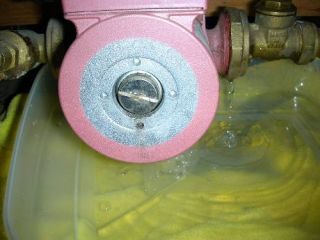
Here you can see that the water is draining into a container, if this water does not stop then the valve is passing and should be replaced.
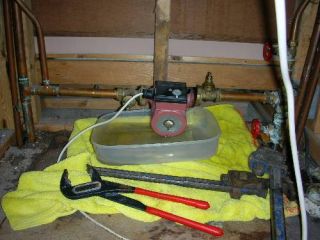
The second pump valve nut was much harder to remove and required the use of stilsons. There will be occasions where it is impossible to remove the pump from the pump valves and so it is best to drain down the system and then replace both valves for new ones.
If you really need to remove the pump and the valves are not passing you can saw off the nut that connects the valve to the pump and fit a new nut. They are manufactured with a flat on the inside of the nut so that you can slide the nut over the threaded part of the isolator.
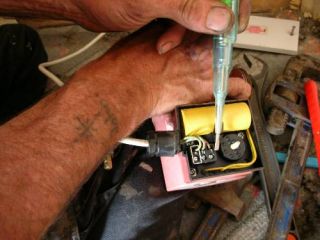
The electrical connections on the pump are quite simple as there is normally only a live, neutral and earth wire to connect. The electrics should always be on top of the pump, to achieve this the pump body may need rotating by undoing the 4 Allen bolts and rotating the head.
After connecting the wires to the pump you can reconnect the pipe work, ensuring that all connecting nuts are tight and not leaking. Open the two isolating valves and then switch the central heating on. You should hear the pump spinning, you can check this by removing the large screw from the centre of the pump.
This screw can also be used to bleed a small amount of air from the pump.



